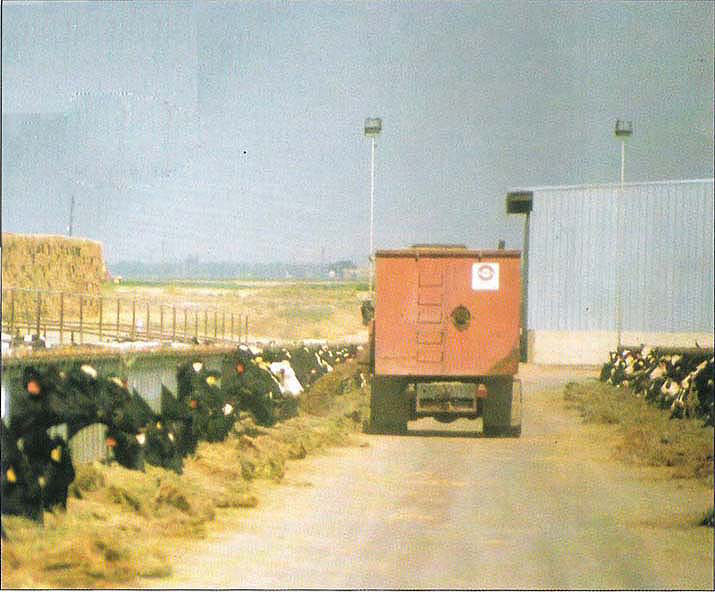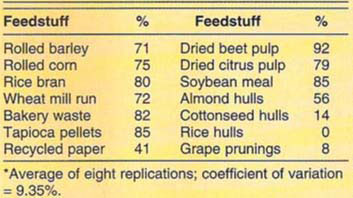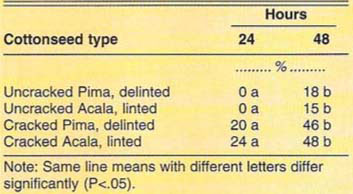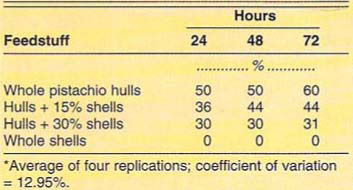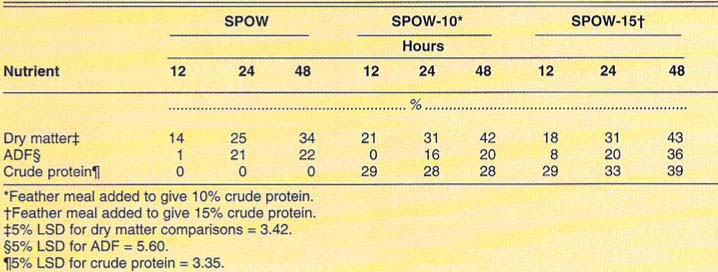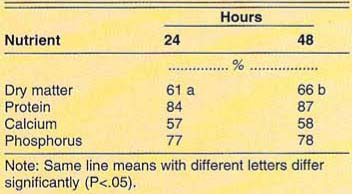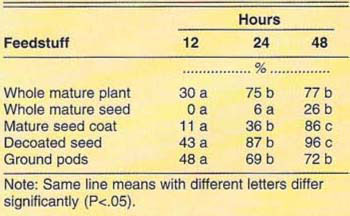All Issues
From dried beet pulp to rice hulls: Rumen digestion of various dairy feedstuffs compared in tests
Publication Information
California Agriculture 47(3):29-31.
Published May 01, 1993
PDF | Citation | Permissions
Abstract
From California's agricultural and livestock industries come a wide variety of possible ingredients for dairy feeding. Relatively limited information exists on the rumen's degradation of these feeds. In tests, disappearance of feedstuffs from suspended dacron bags in the rumen indicates apparent rumen digestibility. Data on observations of both common and relatively new feeds are presented here.
Full text
At a typical, large California dairy, cattle feed on alfalfa and byproducts delivered by mixer truck. See back cover for more photos.
Feed costs represent 45 to 65% of the total cost of milk production and comprise the single largest expense. Economical feed rations employ diverse by-products from agricultural and livestock industries. Also, the feed industry cannot stand still; development and use of cost-effective forage and seed crops are essential. Trends today indicate that California will become the number one milk-producing state in the U.S. by the year 2000. (California is currently second to Wisconsin.) Maximizing profits from the dairy farm will be necessary to maintain a competitive edge.
The digestibility of feedstuffs in the rumen (the second compartment of the cow's stomach) is the principal means by which the dairy cow converts feed into milk. However, some feeds have natural or created bypass characteristics that partially avoid degradation by rumen microbes. Knowledge of rumen digestibility for various feedstuffs assures intelligent diet formulation and avoids nutritional problems for both the rumen microbial population and the host cow.
Obtaining data on the true rumen digestibility of feedstuffs requires using animals equipped with ruminal and duodenal canulae. Feedstuff disappearance from dacron bags in ruminally fistulated animals is a recognized method for estimating apparent digestion. This report compares the apparent rumen digestibility of some common and new dairy feedstuffs for use by nutrition professionals in designing nutritionally balanced, cost-effective dairy rations.
Procedures
Feedstuffs were obtained from various feed producers and commodity enterprises for 2 years. Chemical composition of the feedstuffs was determined by standard Association of Official Agricultural Chemists (AOAC) methods. Obtaining apparent rumen digestibility of feedstuffs with dacron bags is the acceptable technique. Briefly, 2 grams of dry matter for each feedstuff were suspended in the rumen in dacron bags (5 cm x 15 cm; 53-micron pore size) for 3 to 48 hours, depending on observation objective. All feedstuffs were coarsely ground, except for intact or cracked whole cottonseed.
The polyester material is resistant to microbial digestion. Rumen microbes enter through the micro-pores of the dacron bags, digest feed and leave without loss of feed particles or dacron bag integrity. The bags were weighted so as not to float in the rumen and were suspended in groups of 12 per run in a ruminally fistulated steer fitted with a permanent plastic canula to facilitate bag placement and removal. For all observations, the steer was fed daily a 30-pound maintenance ration of 90% alfalfa hay and 10% concentrates. Apparent digestibility was calculated by subtracting bag residue weight from initial sample weight and dividing by initial sample weight, all on a 90% dry matter basis. Results in tables 1 through 8 are separate trials; tables 9 to 12 are a single trial.
Discussion
Table 1 gives percentages for a 24-hour period of apparent rumen digestibility for some ingredients used in California dairy rations. Energy feeds, such as rolled barley and corn, rice bran, wheat mill run, bakery waste and tapioca pellets have a relatively high digestion after 24 hours. Dried beet pulp and citrus pulp are also highly digestible, as is soybean meal. Almond hulls are an intermediate energy source. Cottonseed hulls have relatively low digestion; rice hulls and grape prunings essentially are nondigestible. Recycled paper, of comparatively low-energy value as a by-product feed source, has been used for animal stall bedding as well.
Whole cottonseed, commonly used in dairy rations, is a good source of both protein and energy. Observations in table 2 for Acala and Pima cotton varieties indicate a relatively slow rate of digestion unless the seeds are cracked mechanically or chewed. When there is insufficient long fiber and/or high moisture in the ration, undigested cottonseed can be found in corral manure. This is due, partly, to less chewing and a faster rate of feed passage through the rumen. Scientific literature from the universities of California, Arizona, and Cornell suggest that some cottonseed protein and fat escaping rumen degradation is utilized in the lower digestive tract. Data from Texas A&M University indicate no apparent digestion of intact whole cottonseeds once they leave the rumen.
A relatively new feedstuff potentially available for cattle feeding is the pistachio. Acreage in pistachios in California, mostly between Merced and Bakersfield in the Central Valley, has increased nearly tenfold in the last 15 years. Table 3 shows that pistachio hulls have an apparent rumen digestibility comparable to almond hulls; increasing pistachio shell content, however, lowers feed value. A major limitation for pistachio hulls is that water is used to remove them from the in-shell nuts and dry matter content of the hulls can be as low as 15%. This procedure can be modified, hulling operators have stated, if a feed market is identified.
The ability of cattle to digest fiber in the rumen has enabled steam-processed orchard wood (SPOW) to be used as a feedstuff. Wood chips from orchard prunings and discarded trees are steamed at 450°F (232°C) and 350 psi for 5 minutes. The final product, on a dry matter basis, has 2.5% crude protein and 45% crude fiber. As fed, SPOW has 45 to 55% moisture, with a slight molasses aroma and mild vinegary taste. Table 4 contains rumen digestibility percentages for SPOW and SPOW plus feather meal to raise crude protein to 10 and 15%. Results show a low apparent nutrient digestion after 24 hours in the rumen and a modest increase at 48 hours. It is of interest to note that protein disappearance, apparently of feather meal, increases with steam processing. This is supported by the relatively low rumen digestibility, or high rumen bypass, of protein from both hydrolyzed and unhydrolyzed feather meal not subjected to steam pressure listed in table 5.
Tomato pomace and peel are major agricultural by-products in California. Observations on apparent digestibility of dry matter and fiber in the rumen are presented in table 6. Results suggest the two feedstuffs are of similar nutritional value and would be ranked as intermediate energy sources. In contrast, data in table 7 show chicken litter protein and phosphorus to be highly digestible in the rumen and, when mixed with other feedstuffs, they can provide a balanced ration for replacement heifers. Feeding animal waste to lactating animals is presently not permitted in California.
New varieties of sweet lupin (Lupinus albus) are being developed that are adapted to California's semiarid Central Valley. The mature seed is a potential cash crop. The whole plant could be grown as a winter forage and could fit into local double-crop rotation patterns. Lupins can be a source of protein and fiber for dairy rations. Rumen dacron bag observations on lupins are presented in table 8. The rate of apparent digestion for the whole plant indicates that it could be used as a hay or silage crop. The whole mature seed apparently requires cracking of the seed coat to obtain maximum digestion. However, feeding uncracked seed in concentrates and counting whole seed appearing in manure showed only 23% went undigested after 4 days in the digestive tract. Both the seed coat and pods had highly digestible fiber as determined from the bag suspensions.
Alfalfa hay has been the main ingredient in California dairy rations for many years. Both its fiber and protein make it an extremely valuable ruminant feed. Attention in recent years to amounts of nutrients degraded in the rumen and those that bypass rumen microbial action suggests additional information of this type for alfalfa would be useful in ration formulation.
Core bale samples were randomly taken from various stacks of alfalfa hay being fed on dairies in Tulare County. Samples were taken from the early (April-May), middle (June-July), and late (August-September) growing season and subjected to Near Infrared Reflectance Spectroscopy (NIRS) to estimate crude protein and total digestible nutrients (TDN). A summary of core sample analyses is shown in table 9.
The apparent dry matter and protein niminal digestibilities of alfalfa samples suspended in dacron bags for 3,6,12 and 24 hours are shown in tables 10 and 11. Both dry matter and protein followed a similar trend for a progressively higher extent of rumen degradation with longer suspension times. The respective higher crude protein and TDN values between early-, mid-, and late-season alfalfa gave correspondingly higher apparent digestibilities at the different rumen suspension times. Overall results indicate a moderate rate of ruminal digestion in 24 hours. Prediction equations for dry matter and protein raminal digestibility derived from the data are listed in table 12. These equations permit estimates of alfalfa rumen digestibility, based on laboratory nutrient analyses.
The data on alfalfa presented are from a forage-fed steer. Feed fermentation and rate of passage of a high-producing cow fed a 50% concentrate ration will be faster than that in a steer fed an all-forage diet, and may result in lower ruminal digestibility values for alfalfa than those shown in table 12. This emphasizes the need to know the rumen digestibility rate and degradation capabilities of individual feeds to better formulate dairy ration nutrient components.
Conclusion
In summary, the wide variety of feedstuffs used in dairy feeding and the new feeds that may become available make the formulation of rations complex and dynamic. Dacron bag suspensions in the rumen provide insights on rate of feed and nutrient utilization that can be useful in improving ration formulation and subsequent animal performance, and in improving economic benefits.



